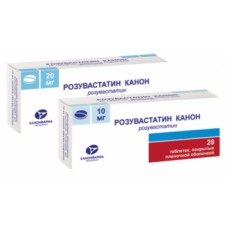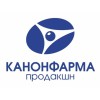Expiration date: 07/2025
Clinico-pharmacological group
(Lipid lowering drug)
Pharmacological action
Lipid-lowering drugs from the group of statins, an inhibitor of HMG-COA reductase. On the principle of competitive antagonism statin molecule binds with the part of the receptor of coenzyme A, where is attached this enzyme. Another part of the molecule of the statin inhibits the process of turning hydroxymethylglutaryl to mevalonate, an intermediary product in the synthesis of molecules of cholesterol. The inhibition of the activity of HMG-COA reductase leads to a series of sequential reactions that result in reduced intracellular cholesterol content and a compensatory increase in the activity of LDL-receptors and, accordingly, acceleration of catabolism of cholesterol (Xc) LDL.
Lipid-lowering effect of statins is associated with a reduction in total Cholesterol due to Cholesterol-LDL. Decrease LDL cholesterol levels is dose-dependent and is not linear, but exponential.
Statins do not affect the activity of lipoprotein lipase and hepatic, no significant effect on the synthesis and catabolism of free fatty acids, so their effect on triglycerides and again vicariously through their main effects are to reduce the level of CH-LDL. A moderate reduction in triglycerides in the treatment of statins, apparently associated with expression remontnyj (APO E) receptors on the surface of hepatocytes involved in the catabolism of LPP the composition of which is approximately 30% TG.
In addition to the hypolipidemic actions, statins have positive effects in endothelial dysfunction (pre-clinical sign of early atherosclerosis), on the vascular wall, the state of atheroma, improves blood rheology, have antioxidant, antiproliferative properties.
Therapeutic effect manifests itself within 1 week. after the start of therapy and after 2 weeks of treatment makes 90% of the maximum possible effect, which is usually reached by 4 week and after that remains constant.
Pharmacokinetics
After the intake of rosuvastatin Cmax in plasma is reached after approximately 5 h. Bioavailability - about 20%.
Rosuvastatin stored in the liver. Vd is approximately 134 L. plasma protein Binding (mainly to albumin) is approximately 90%.
Biotransformiroetsa to a small extent (about 10%), as a non-core substrate for isoenzymes of cytochrome P450. The main isoenzyme involved in the metabolism of rosuvastatin, a is CYP2C9. The isoenzymes CYP2C19, CYP3A4 and CYP2D6 involved in the metabolism to a lesser extent.
The main identified metabolites of rosuvastatin are N-desmethyl and lactonase metabolites. N-desmethyl about 50% less active than rosuvastatin, lactonase metabolites are pharmacologically inactive.
About 90% of the rosuvastatin dose is excreted unchanged in the feces. The remaining part is excreted in the urine. Plasma T1/2 - about 19 h. T1/2 does not change with increasing doses. The mean value of plasma clearance is approximately 50 l/h (coefficient of variation 21.7%).
As in the case of other inhibitors of HMG-COA reducase in the process of hepatic capture of rosuvastatin involved membrane Cholesterol Transporter that performs an important role in the hepatic elimination of rosuvastatin.
Systemic exposure of rosuvastatin increases in proportion to the dose.
In patients with severe renal insufficiency (CC<,30 3="" n-="" 9="" 50="" p="">,
In patients with hepatic impairment, the degree of which was 8 and 9 on a scale child-Pugh noted an increase in T1/2 at least 2 times.
Dosage
Take inside. The recommended starting dose is 10 mg 1 times/day. If necessary, the dose may be increased to 20 mg after 4 weeks. Increase the dose to 40 mg is only possible in patients with severe hypercholesterolemia and high risk of cardiovascular complications (especially in patients with familial hypercholesterolemia) in case of insufficient efficacy at a dose of 20 mg and subject to the supervision of a physician.
Drug interactions
While the use of rosuvastatin and cyclosporine AUC of rosuvastatin was on average 7 times higher than the value which was observed in healthy volunteers, plasma concentration of cyclosporine is not changed.
Beginning of rosuvastatin therapy or increase in dosage in patients receiving both vitamin K antagonists (e.g. warfarin) may cause an increase in prothrombin time and INR, and the abolition of rosuvastatin or lowering the dose may reduce INR (in such cases, monitoring of INR).
The combined use of rosuvastatin and gemfibrozil leads to an increase 2 times the Cmax in plasma and AUC of rosuvastatin.
Concomitant use of rosuvastatin and antacids containing aluminium and magnesium hydroxide, leads to a decrease in plasma concentrations of rosuvastatin by about 50%. This effect is expressed weaker, if antacids are applied through 2 h after administration of rosuvastatin (a clinical significance is unknown).
Concomitant use of rosuvastatin and erythromycin reduces the rosuvastatin AUC by 20% and rosuvastatin Cmax by 30% (probably due to increased intestinal motility caused by erythromycin reception).
Concomitant use of rosuvastatin and oral contraceptives increases the AUC of ethinyl estradiol was norgestrel and AUC of 26% and 34%, respectively. We cannot exclude such an interaction with concomitant use of rosuvastatin and conducting hormone replacement therapy.
Gemfibrozil, other fibrates and lipid lowering doses of Niacin (?1 g/day) increased the risk of myopathy during concomitant use with other inhibitors of HMG-COA reductase possible due to the fact that they can cause myopathy and when used as monotherapy.
The combined use of rosuvastatin and Itraconazole (CYP3A4 inhibitor) increases the AUC of rosuvastatin by 28% (clinically insignificant).
Pregnancy and lactation
Contraindicated during pregnancy and lactation.
Do not use in women of reproductive age, not using reliable methods of contraception.
Side effects
CNS: frequently - headache, dizziness, asthenic syndrome, perhaps – anxiety, depression, insomnia, neuralgia, paresthesia.
From the digestive system: often - constipation, nausea, abdominal pain, possible – reversible, dose-dependent transient increase in liver transaminases, dyspepsia (including diarrhea, flatulence, vomiting), gastritis, gastroenteritis.
The respiratory system: often – pharyngitis may – rhinitis, sinusitis, asthma, bronchitis, cough, dyspnoea, pneumonia.
Of the cardiovascular system: possible angina, increased blood pressure, palpitations, vasodilation.
From the side of musculoskeletal system: often – myalgia, possible – arthralgia, arthritis, hypertonia, back pain, abnormal pearl of the limb (without damage), rare – myopathy, rhabdomyolysis (at the same time with impaired renal function, in patients receiving the drug in a dose 40 mg).
From the urinary system: tubular proteinuria (less than 1% of cases for doses 10 and 20 mg, 3% of cases for dose 40 mg), possible peripheral edema (hands, feet, ankles, lower legs), pain in the lower abdomen, infections of urinary system.
Allergic reactions: possible skin rashes, itching, rarely – angioedema.
From the laboratory parameters: transient dose-dependent increase in the activity of KFK (when increased activity of KFK is more than 5 times compared with CAH therapy should be temporarily suspended).
Other: often – asthenic syndrome, perhaps - accidental injury, anemia, chest pain, diabetes, ekhimozy, flu-like syndrome, periodontal abscess.
Testimony
Hypercholesterolemia (type IIa, including family heterozygous hypercholesterolemia) hypercholesterolemia or mixed (type IIb) as an adjunct to diet when diet and other non-pharmacological treatments (e.g. exercise, weight reduction) are inadequate.
Family homozygous hypercholesterolemia as an adjunct to diet and other cholesterinspiegel therapy or in cases where such treatment is not appropriate for the patient.
Contraindications
Liver disease in active phase (including the persistent increase in liver transaminases or any elevation of transaminases more than 3 times compared with CAH), expressed by the human kidney (QC<,30 18="" p="">,
Special instructions
To apply caution in the presence of risk factors for the development of rhabdomyolysis (including renal impairment, hypothyroidism, personal or family history of hereditary muscular diseases and previous history of muscular toxicity with other inhibitors of HMG-COA reductase inhibitors or fibrates), chronic alcoholism, in patients older than 65 years, with liver diseases in history, sepsis, arterial hypotension, when performing extensive surgical interventions, injuries, severe metabolic endocrine or electrolyte disorders, with uncontrolled epilepsy, in individuals of Asian descent (Chinese, Japanese).
Therapy should be discontinued if the CPK level increased significantly (more than 5 times compared with CAH), or if muscle symptoms are pronounced and cause daily discomfort (even if the CPK level is 5 times less compared to the ULN).
With the use of rosuvastatin in dose 40 mg is recommended to monitor indicators of kidney function.
In most cases, proteinuria decreases or disappears during therapy and does not mean the occurrence of acute or progression of existing renal diseases.
There is a reported increase in the incidence of myositis and myopathy in patients taking other inhibitors of HMG-COA reductase inhibitor in combination with fibrin acid derivatives (including gemfibrozil), cyclosporine, nicotinic acid, azole antifungals, protease inhibitors and macrolide antibiotics. Gemfibrozil increases risk of myopathy when combined administration of some inhibitors of HMG-COA reductase. Thus, not recommended simultaneous with the appointment of rosuvastatin and gemfibrozil. You should carefully weigh the risks and potential benefits when used together, rosuvastatin and fibrates or Niacin.
Recommended definition of indicators of liver function before therapy and 3 months after initiation of therapy. The use of rosuvastatin should stop or reduce the dose if the level transaminaz in the serum in 3 times the VGN.
In patients with hypercholesterolemia due to hypothyroidism or nefroticski syndrome therapy major diseases should be carried out before starting treatment with rosuvastatin.
Effects on ability to drive vehicles and management mechanisms
In potentially hazardous activities patients should be aware that during the treatment may occur dizziness.
Use in impaired renal function
Contraindicated when expressed violations kidney function (QC<,30 p="">,
Use in hepatic impairment
Contraindicated in liver disease in active phase (including the persistent increase in liver transaminases or any elevation of transaminases more than 3 times compared with CAH).


